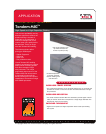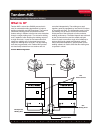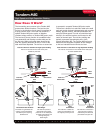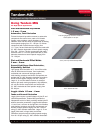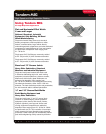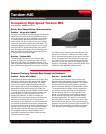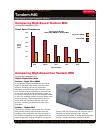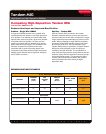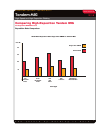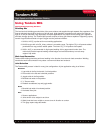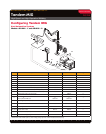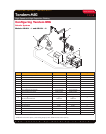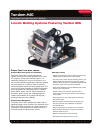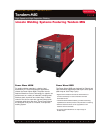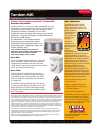
The future of welding is here.
®
APPLICATION
6/16
WAVEFORM CONTROL TECHNOLOGY
TM
Tandem MIG
High-Speed and High-Deposition Welding
Problem - Single Wire GMAW
As higher travel speeds are explored with conventional
single solid and metal cored wire GMAW processes
one of the factors that limits obtainable travel speeds
is a phenomenon referred to as “bead humping” or
lack of follow. The lack of follow occurs as a number
of physical metal flow requirements break down. The
coalescent properties of the weld pool are not strong
enough to pull the puddle along while, at the same
time, the higher travel speeds limit the heating of the
plate that would normally allow the weld pool to wet
or flow along the weld bead edges.
Solution - Tandem MIG
The spacing of the two arcs of the Tandem MIG
process is designed to overcome the lack of follow
associated with single wire GMAW processes. The
lead arc provides initial penetration into the base plate
and a preheating of the plate for the trail arc. The trail
12 Gauge Lap Weld
at 120 ipm travel
arc rides the pool created by the lead electrode, the
pressure from the trail arc flattens the created weld
pool to eliminate the tendency for the pool to rise and
hump. The applied weld pool pressure from the trail
arc is used to not only limit the tendency of the lead
weld pool to hump and lose follow capability, but the
pressure is adjustable, allowing the bead contour to be
modified to meet application requirements.
Comparing High-Speed Tandem MIG
To Single Wire GMAW Processes
Reduced Tendency Towards Burn-through and Undercut
Problem - Single Wire GMAW
Increased travel speeds require the use of larger wire
diameters or higher wire feed speeds. Both choices
will cause an increase in current draw. The added
current draw creates added penetration that must
be managed. With a single wire GMAW process the
penetration is most intense at the point where the
axial flow of material from the welding wire is directed
on to the plate. This area is focused to a small area
that is generally the cross-sectional area of the
welding wire diameter. In order to manage the
additional finely focused penetration wire placement
becomes more demanding, joint fit-up becomes
more critical. If joint alignment is not maintained and
the welding arc wanders off the seam, concentrating
the arc on a single metal thickness, burn-through is a
common result. If joint fit-up is not maintained welds
often penetrate well into the open joint creating an
unacceptable undercut. If the penetration is not
successfully managed the common result is costly
increased rework or scrap.
Better Weld Metal Follow Characteristics:
Solution - Tandem MIG
The Tandem MIG process is able to achieve the
high wire feed requirements of high speed welding
without creating excessive penetration. The required
wire feed total for high speed welding is shared by
the two electrodes forming the Tandem MIG process.
The shared wired feed speed not only reduces the
current draw on each individual arc but disperses
the total welding energy over two separate focal
points. The separation of the two focal penetration
points allows more metal to be deposited without
excessive penetration. The lead arc is focused on
the plate while the trail arc is focused on the molten
pool created by the lead arc. The trail wire energy is
applied to the pool and not directly onto the plate. This
limits the overall penetration and allows the process
to be tolerant of joint misalignment and joint gaps.



